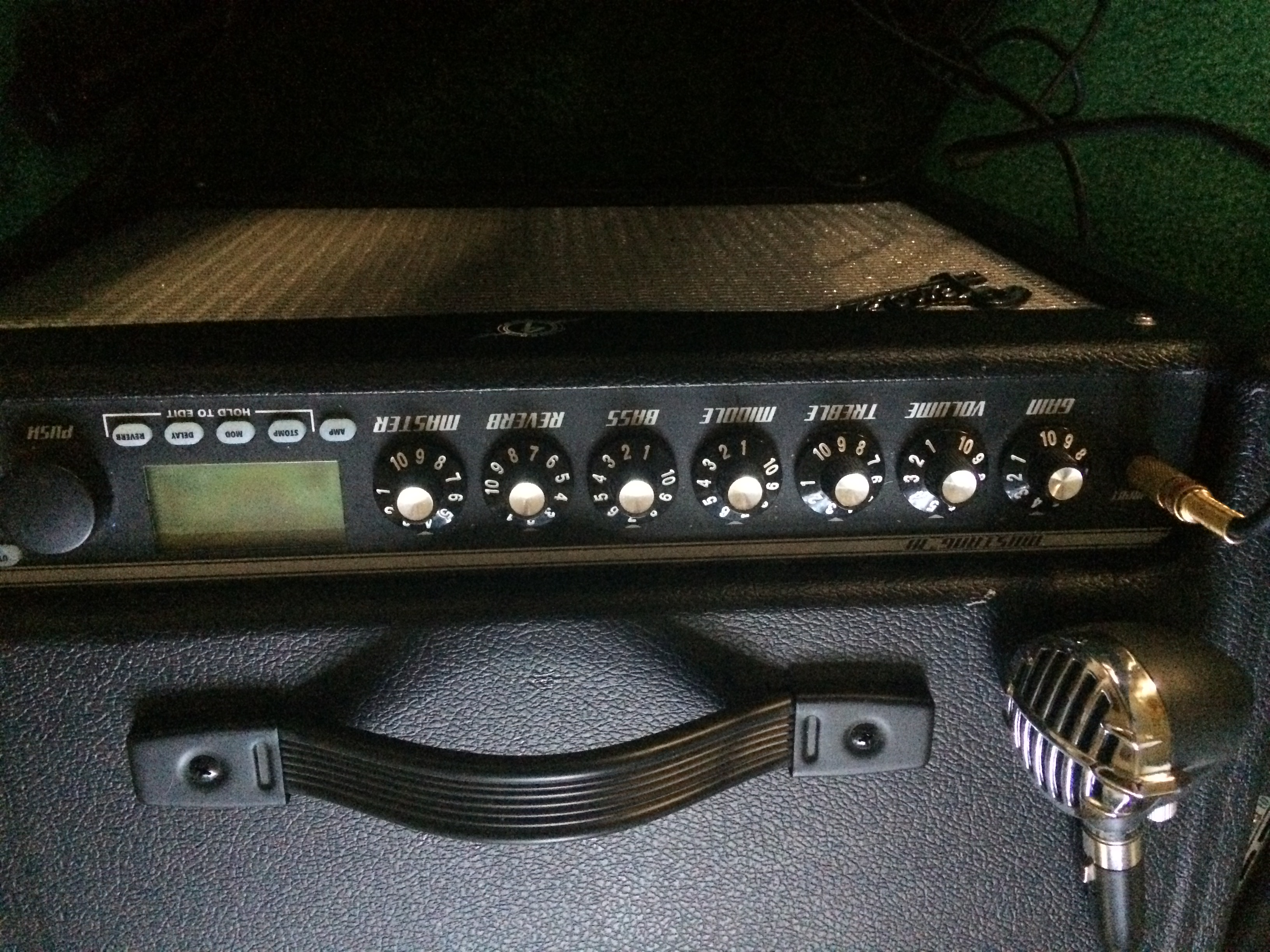
The Fender Mustang in the Studio: Like, Perfect
I had the opportunity last weekend to use my Fender Mustang III amp in the studio for the “Blue Future” sessions. In a word, it was perfect for recording a wide range of amped and clean tones. (I wouldn’t mind if it weighed ten pounds less, so I guess that’s not perfect, but the sound and ease of use sure were.)
I discovered something interesting about this amp while we were recording. The Master Volume control on the front panel only controls the output from the speaker. The Master Volume control has no effect on the signal from the XLR outs. That means you can put as much or as little sound into the room via the speaker as you want while maintaining a clear signal from the line-outs. That’s perfect when you want to be in the room with the musicians, but you don’t want a whole lot of spill from the amp into other peoples’ microphones. When we put the amp into the room with the musicians, we turned the Master Volume down to zero and listened on headphones while recording. When we put the amp into its isolation booth, we turned it up so I could get the feel of the air moving. Perfect.
Listening to the rough takes from that session in my home studio, the amp-modeled tracks are, well, perfect. Of the seven tracks I recorded last weekend, four were recorded with the Mustang. Three of those tracks used a slightly modified version of the “Bassman Mono DL” patch from my patchset for the Fender Mustang. I made all the changes in the tone–add a little treble, reduce the gain, take the delay off–with the front panel controls, just as I would with a “real” amp. I saved the changes so that I can recall the exact same tones for overdubs later, which is one of the BIG advantages of working with a modeling device recorded direct to the board: no matter where or when you record, you can get the exact same sound any time you need it. I used amped-up Bassman modeled tones with the Shure SM58 mic for the tough blues numbers, and I used the Audix Fireball V coupled with a Mustang patch based on the Studio Preamp (i.e. squeaky clean) model for clean tones on my instrumental “Big 17.” That piece includes a lot of 4- and 5-note chords that just don’t work with a lot of distortion laid on. Distortion on big close-voiced harmonica chords turns everything into a big loud blur–not really effective if you want that chord to mean something harmonically. Which in this case I do.

I brought five mics to the session, tried three of them (Fireball V, SM58, and Shaker Dynamic), and ended up using two: the SM58 and the Fireball V. I recorded one piece standing in front of a high-end large diaphragm condenser mic supplied by Pete Rydberg, the engineer. (And of course the harmonica tones on that piece are big, lush, detailed, and beautiful.) We had a Blue Bottle mic (Blue is the manufacturer, Bottle is the name of the mic) in the iso booth, and some of the tracks were recorded simultaneously from that mic and the Mustang so we can put a little more clean into the tone later if we like.
The effects in my Digitech RP500 are more numerous and varied (and often better) than the Mustang’s, and when I needed to record a waka-waka filter sound for my song “Disconnected Blues,” I used the RP. (Nothing beats the FX25 envelope filter model in the RP500 for waka-waka.) But for straight-up amped and clean tones, with and without reverb and delay, in traditional styles, this Mustang is da bomb.
I’m really glad I added the Mustang III to my trick bag, and I anticipate using it a lot more in future. Stay tuned for clips of the harp sounds from “Blue Future.”
If you liked that, you’ll like these:
the 21st century blues harmonica manifesto in sound
Get it on Amazon
Get it on iTunes
the rock harmonica masterpiece
Get it on Amazon
Get it on iTunes
Tags In
Related Posts
2 Comments
Leave a Reply
You must be logged in to post a comment.
WHAT’S NEW
Categories
- Audio/Video
- Blog
- Blue Future
- Digitech RP Tricks and Tips
- Discography, CDs, Projects, Info, Notes
- Featured Video
- For the Beginner
- Gallery
- Hunter's Effects
- Hunter's Music
- Huntersounds for Fender Mustang
- Meet the Pros
- More Video
- MPH: Maw/Preston/Hunter
- My Three Big Contributions
- Player's Resources
- Pro Tips & Techniques
- Recommended Artists & Recordings
- Recommended Gear
- Recorded Performances
- Reviews, Interviews, Testimonials
- The Lucky One
- Uncategorized
- Upcoming Performances
- Zoom G3 Tips and Tricks




Richard, the Fender Mustang Amps sound very interesting, but asvfar as I see, they only have one instrumental input, even the newer Gt 100/200. How do you combine your harp playing with singing? Vocal mic to a second amp, direct in the PA, or to AUX or FX return (is that advisable?)? I would like to keep it simple, and I know you do it too, using a multi channel amp like the Peavey earlier on.
Cheers, Ande
I use a different setup for vocals, and use the Mustang for harp.